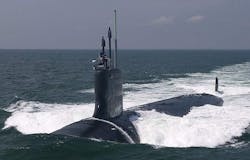L-3 to build six more TB-29A CTA towed array sonar systems for Virginia-class submarines
WASHINGTON – Sonar designers at L-3 Chesapeake Sciences Corp. in Millersville, Md., are building the U.S. Navy's next-generation towed-arraysonar for submarines and unmanned surface vessels (USVs) to detect, track, and classify quiet, modern submarine threats in open ocean and littoral waters.
Officials of the Naval Sea Systems Command in Washington announced a $13.6 million order to L-3 Chesapeake on Friday to build six more TB-29A Compact Towed Array (CTA) production-representative towed-array sonar systems for Navy Virginia-class fast-attack submarines.
The order is a modification to a $20.8 million contract announced in April 2015 for an initial six TB-29A CTA production-representative towed-array sonar systems for Virginia-class submarines.
The TB-29A CTA represents the next generation of sonar array technology; it is a reliability improvement array that incorporates CTA telemetry while maintaining TB-29A acoustic performance.
Related: Navy asks Lockheed Martin to build towed-array sonar systems for Navy surface warships
Current towed-array sonar systems, including TB-23, the non-CTA TB-29A, TB-16, and Multi-Function Towed Array (MFTA) provide acoustic performance but are not optimal for deployment from unmanned vehicles, Navy officials say.
Towed array sonar uses hydrophones towed on a cable trailing behind a submarine or a surface ship; it can be miles long. It's designed to keep the array's sensors away from tow vessel noise to improve its signal-to-noise ratio and its ability to detect and track faint contacts like quiet nuclear- and diesel-powered submarines and seismic signals.
Effective use of towed array sonar systems limit a vessel's speed, and crews must take care to protect the cable from damage. Current towed-array systems also are complex designs and need to be upgraded to maintain reliability while deployed, while stowed, and while reeling the array in and out of submarines and other marine vessels.
Compared with existing towed arrays, the L-3 Chesapeake TB-29A CTA offers significant reduction in sensor power, internal component diameter, bend radius, and production costs.
The TB-29A CTA submarine thin-line array is designed to reduce complexity, lower power, and improve robustness to withstand in-situ operations and stresses of handling systems, Navy officials say.
Its performance telemetry, acoustic sensors, and electronics are designed to provide a ubiquitous solution across the spectrum of submarine, surveillance, and unmanned towed arrays. This multi-mission commonality for these high-volume and unique components provides cost savings from procurement to life cycle support.
The TB-29A common towed array architecture provides the Navy with major technical advancements in towed array capabilities, Navy officials say. It can be used aboard attack, cruise-missile, and ballistic-missile submarines, as well as on unmanned surface vessels.
For more information contact L-3 Chesapeake Sciences online at www.l-3mps.com/csc, or Naval Sea Systems Command at www.navsea.navy.mil.
Learn more: search the Aerospace & Defense Buyer's Guide for companies, new products, press releases, and videos

John Keller | Editor
John Keller is editor-in-chief of Military & Aerospace Electronics magazine, which provides extensive coverage and analysis of enabling electronic and optoelectronic technologies in military, space, and commercial aviation applications. A member of the Military & Aerospace Electronics staff since the magazine's founding in 1989, Mr. Keller took over as chief editor in 1995.

